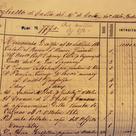-
HHB Working Paper no. 9 – “No country for young people. Poverty and age in Italy, 1948-2018” – explores the changing risk of poverty for older and younger generations of Italians throughout the republican period.
The authors show that poverty rates have decreased steadily for all age groups, but that youth has been left behind: by 2016, children aged 0-17 are 5 times likelier to be poor than someone in the age range of their grandparents – an intergenerational reversal of fortune that is unprecedented in Italy’s post-WW2 history.
Massimo Baldini, Giulia Mancini, and Giovanni Vecchi also assess the impact of the Great Recession on living standards by age, finding that the young have been hit hardest, particularly in Southern regions. What explains the extra poverty risk associated with young age? Read the paper to find out.
-
HHB continues to improve coverage of the right tail of the income distribution (the super-rich), with the goal of producing better estimates of economic inequality in the long run. For this, historical family archives are crucial: they preserve the family budgets of generations of noblemen and aristocrats.
HHB will soon launch a project focused on the historical family archive of the Pepi family of Florence.
The family dates back to the 11th century, and it is believed that its name derives from having had the monopoly of the pepper trade in Florence. A prominent exponent is Ruberto Pepi (1572-1634), a spice merchant and one of the first bankers in Florence, who married Isabella de' Medici in 1608 and made the family one of the protagonists of the Florentine society. The Pepi family still lives in Palazzo Pepi, where the Family Archive is currently preserved.
-
Registers and records of Brazilian plantations in the 19th century, especially in the province of São Paulo, provide a unique source for the compilation of historical household budgets. Since the 1840s, coffee planters employed workers – mainly European immigrants – using contracts in which labor and credit were interlinked. Such a system involved methodical bookkeeping of households’ debts and expenditures. Given the distance of the farms from urban centers, the farms also frequently supplied consumption goods to the families, so that the records frequently detail individual items consumed by the families.
In their paper (forthcoming in the HHB Working Paper Series), Bruno Gabriel Witzel de Souza and Leonardo Antonio Santin Gardenal discuss a newly available source of this type, namely the records of farm Ibicaba. Currently located in the municipality of Cordeirópolis, in the state of São Paulo, farm Ibicaba was the first plantation to employ German-speaking and Portuguese sharecroppers since the 1840s. The source here refers to the farm’s records starting in 1891 and spanning until the 1950s. Despite being limited to a single plantation, the authors argue that the historical importance of farm Ibicaba justifies a deeper exploration of its records. The paper further discusses questions of sample selection and the representativeness of the dataset for the rural economy of São Paulo.
Bruno Witzel will present this new source at a new HHB Seminar on Wednesday, May 30th, hosted by the HHB Headquarters in Tor Vergata. He will also discuss some insights from his PhD thesis on immigration and the organization of rural labor markets in Brazil during the period of transition from slavery.
Acknowledgments: The authors would like to thank Theodoro Hayden Carvalhaes for the allowance to conduct a pilot analysis of the farm’s records; and to Paulo Tamiazo, Renato Timm, and Sven Dinklage for the co-organization of a colloquium that commemorated the 200 years of foundation of farm Ibicaba.
-
HHB is glad to welcome Marianna Brunetti – Associate Professor in Economic Statistics at the Department of Economics and Finance, University of Rome “Tor Vergata” – as a new HHB Researcher.
Prof. Brunetti holds a PhD in “Computational Methods for Financial and Economic Forecasting and Decisions” (University of Bergamo, 2006) and, before joining Tor Vergata in 2007, she held a Post-doc Fellowship at the University of Modena and Reggio Emilia. She has also been Visiting professor at the Imperial College Business School (London) and Researcher at the Stockholm School of Economics.
Her research focuses mainly on household finance, ageing and financial markets, financial markets and business cycle, macroeconomic forecasts, and financial markets efficiency.
-
The super-rich are notoriously under-represented in household expenditure surveys (see here), which can lead to biased inequality estimates. The budget of Filippo Massimiliano del Drago Biscia Gentili, Prince of Mazzano and Antuni, and his family, for the year 1881, is an example of how the HHB project overcomes this issue.
The Prince, born in Rome in 1824, was a descendant of Augustus III King of Poland and of Louis IX King of France. His wife, María Milagros Muñoz y Borbón, was the daughter of María Cristina de Borbón, Princess of the Two Sicilies and Regent of Spain between 1833 to 1840. A noble family indeed, even if the house of del Drago had been ennobled only in 1832, with Filippo’s father, for the services rendered to the Pope.
The household accounts of the Prince – compiled by the Maestro di Casa Attilio Bedini, bursar of the family – clearly document his conspicuous wealth, with household expenditures amounting to 234,000 Italian lire per year in 1881 (more than 1 million euros, at current prices). The noble family spent almost 6 times as much as the richest household recorded so far by HHB for 1881 Italy.





